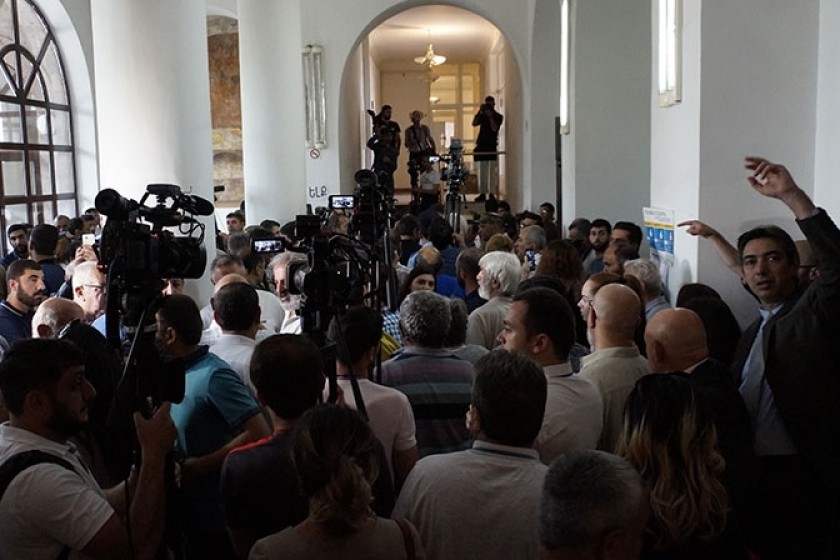
Jirayr Sefilyan’s Trial and Revolutionary Armenia
By Arakel Minassian
On Wednesday May 30, I joined Hetq’s reporters as an observer at the trial of Jirayr Sefilyan and six other defendants in Yerevan.
Sefilyan, the leader of the Founding Parliament opposition movement, is appealing the ten-year sentence handed him in March for conspiracy to foment public disorder, illegal arms possession, and conspiracy to seize government buildings.
The defendants were not brought to trial, and the proceedings were pushed back to June 6. Sefilyan’s supporters responded by staging a demonstration in front of the Prosecutor General’s office and the Court of Cassation. What can we make of these events in the aftermath of Armenia’s “Velvet Revolution?”
The anger in the courtroom was palpable as Judge Ruzanna Barseghyan read the statement from the Yerevan Chief of Police, claiming that the officers could not escort Jirayr Sefilyan and the six other detainees to trial. The judges placed the blame wholly on the police, claiming that they had submitted a request for the defendants to appear in court, but that they had only learned 15 minutes before trial that the police faced technical difficulties, and thus could not escort the detainees. There were shouts of disbelief and anger from the crowd, too big to fit comfortably in the small courtroom.
Garo Yegnukyan, one of Sefilyan’s supporters, who was himself just released from detention on bail, countered that he heard from a source in the police that there were no technical issues at all, but rather, that they were afraid of public demonstrations and street closures if Sefilyan were brought to trial. Incidentally, it was the decision not to escort the defendants that resulted in demonstrations, as Sefilyan’s supporters proceeded to march from the Court of Appeals to the Cassation Court, where they had further issues to address.
A complaint had been sent to the court by the defendants’ attorneys regarding their decision two weeks ago to keep Sefilyan in pre-trial detention. Arriving at the Court of Cassation, officials approached the crowd to say that the complaint had been received and sent back to the attorneys by post, with instructions on changes that needed to be made to their document. Protestors then moved to the Prosecutor General’s office to continue their demonstrations.
Authorities seem to be stalling on both the issues of Sefilyan’s pre-trial detention and his release from prison altogether. Such actions are not new for the Armenian judiciary, which has used the excuse of technical difficulties not to bring defendants to trial in the past, most recently during the Sasna Dzrer trials, proceedings closely related to Sefilyan’s appeal. After the trial, Garo Ghazaryan, member of the Armenian Bar Association of America, said that he did not see justice that day – that every defendant has a right to their day in court. And truly, the continued excuse that technical difficulties stopped the police from bringing the defendants to court, is difficult to believe. The judiciary should examine the arguments on both sides, and decide one way or another, both on the issue of pre-trial detention, and of ultimate imprisonment, rather than allowing the cases to continue to drag on due to minute details.
On the other hand, there does seem to be a genuine fear of public demonstrations by Sefilyan’s supporters, who may not be willing to accept anything less than their leader’s absolute freedom. Marching from the Appeals Court to the Court of Cassation, protesters called out “freedom” and “Jirayr.” The court’s history of corruption and subservience to the old regime will likely make any unfavourable verdict appear unjust, and thus action, perhaps even civil disobedience, may be perceived as necessary to bring about a correct result.
Prime Minister Nikol Pashinyan has twice called on citizens to stop all acts of civil disobedience, calling them sabotage of a government that enjoys the support of the people. And yet, the protest leaders made it abundantly clear on Wednesday that their qualms were not with Pashinyan, but rather with a corrupt judiciary. Speaking through a megaphone, Jirayr Sefilyan’s brother Toros said that the court and the police had tried to drive a wedge between his brother’s supporters and the new government, to sabotage its actions. He continued by saying that this attempt would not succeed; their movement and the new Prime Minister made up one family, and one body. These sentiments were reiterated repeatedly by various movement leaders.
Pashinyan has said that all issues of political prisoners should be dealt with in the framework of the law. But what happens when the law fails, or has already failed? It is true, the problem of a dysfunctional judiciary will not be solved overnight, but neither can it necessarily be solved by Pashinyan and his governing ministers alone. What Wednesday’s protests represent is not sabotage of the new government, but rather continued pressure on a network of oligarchs that still carries strong coercive capacities and has historically used those capacities with regards to the judiciary.
Wednesday’s protest was small, comprising no more than 200 individuals. If Sefilyan is again convicted on June 6, subsequent protests may not occur at all, they may be no larger than those on Wednesday, or they may be much larger. They may wane in hours, or they may carry on for days. And if they do carry on, it will be out of recognition that the revolution is not over, but that there is still much work to be done, and that the people, united against a corrupt judiciary, are willing to help in that work.
Arakel Minassian is an incoming Master’s student in Russian, East European, and Eurasian Studies from Toronto, Canada, now in Yerevan as a volunteer with the Birthright Armenia program.
 Videos
Videos Photos
Photos




Write a comment